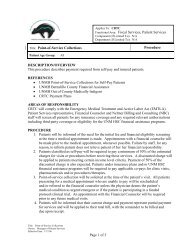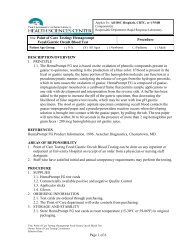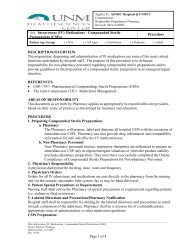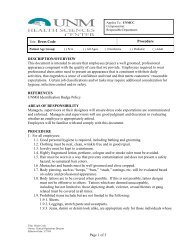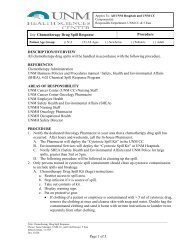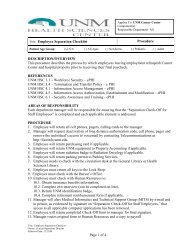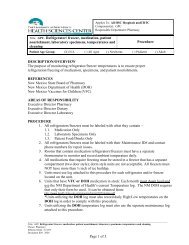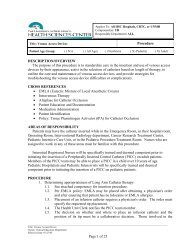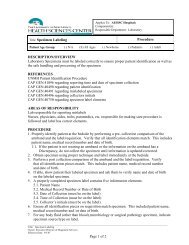Title: Nursing Chain of Command for Deterioration of Patient ...
Title: Nursing Chain of Command for Deterioration of Patient ...
Title: Nursing Chain of Command for Deterioration of Patient ...
Create successful ePaper yourself
Turn your PDF publications into a flip-book with our unique Google optimized e-Paper software.
<strong>Title</strong>: <strong>Nursing</strong> <strong>Chain</strong> <strong>of</strong> <strong>Command</strong> <strong>for</strong> <strong>Deterioration</strong> <strong>of</strong> <strong>Patient</strong><br />
Condition and/or Medical Follow-up<br />
Applies To: All HSC Hospitals<br />
Component(s):<br />
Responsible Department: <strong>Nursing</strong> Leadership, NEC<br />
Procedure<br />
<strong>Patient</strong> Age Group: ( ) N/A () All Ages ( ) Newborns (X) Pediatric (X) Adult<br />
DESCRIPTION/OVERVIEW<br />
This procedure provides patient care staff guidance <strong>for</strong> ensuring effective communication and<br />
patient care, when the usual chain is disrupted due to unusual circumstance.<br />
Three algorithms are discussed in this document:<br />
• <strong>Chain</strong> <strong>of</strong> <strong>Command</strong> which provides nursing with the direction to move up the chain as<br />
patient care warrants (Attachment A);<br />
• <strong>Deterioration</strong> in <strong>Patient</strong> Condition which provides nursing with the direction to escalate<br />
medical support (Attachment B) and seek immediate in-house medical back-up;<br />
• Activation <strong>of</strong> the Rapid Response Team when a patient condition changes or is suspected <strong>of</strong><br />
changing, and the medical support is not immediately available (Attachment C).<br />
REFERENCES<br />
• Preparation <strong>of</strong> this document was completed by review <strong>of</strong> documents from the following<br />
University Hospital Consortium (UHC) members:<br />
• North Carolina Baptist Hospital, 11/2005, <strong>Nursing</strong> Leadership.<br />
• Rush University Medical Center, 10/2005. Peter Butler, EVP.<br />
• Syracuse University Medical Center, 8/2005: <strong>Patient</strong> Safety Committee.<br />
• Vanderbilt University, 11/2005, Marilyn Dupree, CNO.<br />
• Protecting 5 Million Lives from Harm Campaign, Institute <strong>for</strong> Health Care Improvement<br />
(IHI), 2007. www.ihi.org<br />
AREAS OF RESPONSIBILITY<br />
The registered nurse (RN) assigned to the patient or supervising the care <strong>of</strong> the patient is<br />
responsible <strong>for</strong> notification <strong>of</strong> and communication to the medical staff regarding significant changes<br />
or significant deterioration in the patient's condition, and <strong>for</strong> assuring that there is a physician<br />
response. The RN assigned to the patient or supervising the care <strong>of</strong> the patient is also responsible<br />
<strong>for</strong> documentation <strong>of</strong> the events, as well as the contacts and the results <strong>of</strong> chain <strong>of</strong> command<br />
notifications. In situations where emergent care is warranted and a physician response is delayed,<br />
the RN will activate the rapid response team.<br />
PROCEDURE<br />
Changes in the condition <strong>of</strong> the patient are determined by assessments utilizing parameters defined<br />
in clinical practice guidelines, physician orders, the patient's previous condition, and/or by patient<br />
safety factors.<br />
1. The RN notifies the responsible physician utilizing appropriate channels and chain <strong>of</strong> command.<br />
Notify physicians in the following order unless otherwise indicated by physician order, by<br />
routine or service, or as indicated by the patient condition (Attachment A):<br />
1.1 House <strong>of</strong>ficer who is medically responsible <strong>for</strong> the care <strong>of</strong> the patient;<br />
1.2 Senior and/or Chief Resident and/or Fellow (if applicable)<br />
<strong>Title</strong>: <strong>Nursing</strong> <strong>Chain</strong> <strong>of</strong> <strong>Command</strong> <strong>for</strong> Deteriorating <strong>Patient</strong> Condition and/or Medical Follow-up<br />
Owner: <strong>Nursing</strong> Leadership<br />
Effective Date: 12/12/2008<br />
Doc. #2414<br />
Page 1 <strong>of</strong> 7
1.3 Attending Physician<br />
1.4 Executive Medical Director<br />
1.5 Clinical Affairs On-call<br />
1.6 Some services have additional resources (example: the on-call doctor with the medicine<br />
service) and those are considered within the procedure.<br />
2. For ongoing concerns with physician response, the RN must notify appropriate nursing<br />
leadership <strong>for</strong> support and/or to pursue unresolved issues (Attachment A): Weekday Dayshift:<br />
RN Supervisor, Unit Director, Executive Director, and Chief <strong>Nursing</strong> Officer.<br />
Nightshift/Weekend Dayshift: RN Supervisor, Administrative Supervisor, Administrator Oncall.<br />
3. If there is no response and the situation warrants rapid intervention, call the Rapid Response<br />
Team <strong>for</strong> assistance.<br />
3.1. The RRT activates the <strong>Chain</strong> <strong>of</strong> <strong>Command</strong> if not already activated. For all RRT calls<br />
initiated due to acute patient instability, the administrative supervisor team member is<br />
required to contact the attending.<br />
3.2. <strong>Patient</strong>s who are actively and rapidly deteriorating may be moved to an ICU bed<br />
immediately. Delays in moving patients will be avoided by immediate contact <strong>of</strong> the unit<br />
attending when consensus is not achieved with the ICU resident.<br />
4. Document in the medical record the date, time, and name <strong>of</strong> each physician notified, actions<br />
taken, and/or patient's response to treatment.<br />
5. When the ICU team responds, the team will contact their fellow or attending <strong>for</strong> any situation in<br />
which they believe the patient does not need a higher level <strong>of</strong> care. In situations where the<br />
required level <strong>of</strong> nursing care will exceed the unit resources, the administrator on-duty will use<br />
the chain <strong>of</strong> command to resolve the situation.<br />
6. The RN will per<strong>for</strong>m an initial admission assessment that should be documented and serve as the<br />
baseline from which subsequent assessments should be compared in order to determine significant<br />
changes that warrant nursing intervention including notification <strong>of</strong> the physician.<br />
7. The RN is responsible <strong>for</strong> communicating patient status to the physician any changes in the<br />
patient's condition that may warrant treatment.<br />
8. The RN should use the unit standards <strong>of</strong> care, physician orders <strong>for</strong> patient parameters, or Rapid<br />
Response Team triggers <strong>for</strong> guidance as needed.<br />
9. Condition changes that warrant notification <strong>of</strong> a physician may include, (but are not limited to):<br />
9.1. <strong>Deterioration</strong> in level <strong>of</strong> consciousness<br />
9.2. Alteration in temperature<br />
9.3. <strong>Deterioration</strong> <strong>of</strong> vital signs<br />
9.4. Alteration in urine output<br />
9.5. Critical lab results<br />
9.6. Evidence <strong>of</strong> bleeding or infection<br />
9.7. Deteriorating cardiac rhythm<br />
9.8. Chest pain/shortness <strong>of</strong> breath<br />
9.9. Increased complaints <strong>of</strong> pain, despite medication<br />
9.10 Continued deterioration in patient condition despite interventions<br />
10. The RN should notify the physician if initial received orders and subsequent interventions do<br />
not resolve the patient condition.<br />
11. The physician is responsible <strong>for</strong> responding in a timely fashion and giving clear direction.<br />
12. If the RN has concerns with regard to the therapeutic interventions, these concerns should be<br />
shared with the physician, and then the next level <strong>of</strong> the physician and nursing chain <strong>of</strong><br />
command.<br />
<strong>Title</strong>: <strong>Nursing</strong> <strong>Chain</strong> <strong>of</strong> <strong>Command</strong> <strong>for</strong> Deteriorating <strong>Patient</strong> Condition and/or Medical Follow-up<br />
Owner: <strong>Nursing</strong> Leadership<br />
Effective Date: 12/12/2008<br />
Doc. #2414<br />
Page 2 <strong>of</strong> 7
15. Documentation essentials;<br />
15.1 Significant changes in patient status are documented on the <strong>Patient</strong> Care Flowsheet,<br />
including the “who, what, where and when” <strong>of</strong> pertinent communications.<br />
15.2 Rapid Response Team members also complete a Rapid Response Log.<br />
15.3 A Cardiopulmonary Arrest Record (aka Dr. Heart <strong>for</strong>m) is completed <strong>for</strong> patients in<br />
cardiac arrest.<br />
*If you feel that the physician interventions are insufficient to meet the needs <strong>of</strong> the patient continue<br />
to use the <strong>Nursing</strong> and Physician <strong>Chain</strong>s to ensure the care provided is appropriate or if additional<br />
interventions are warranted.<br />
Unit Area Specifics<br />
All Behavioral Health Inpatient areas activate a medical response team to respond to<br />
deterioration in a patient’s medical condition. Significant changes in patient status are<br />
documented in the electronic medical record and the medical emergency response <strong>for</strong>m. Such<br />
documentation includes the “who, what, where and when” <strong>of</strong> pertinent communications,<br />
including if 911 was called and ambulance transfer to an emergency was necessary<br />
DEFINITIONS:<br />
<strong>Chain</strong> <strong>of</strong> <strong>Command</strong>: the progressive escalation in seniority rank <strong>of</strong> personnel on the medical and<br />
nursing leadership teams.<br />
Dr. Heart: the hospital code alert system <strong>for</strong> a team that responds to assist patients in<br />
cardiolpulmonary arrest.<br />
Rapid Response Team: the multidisciplinary team (EMT-P, MD, RN, RCP, etc.) that responds to a<br />
staff call <strong>for</strong> assistance <strong>for</strong> a patient’s whose condition has deteriorated.<br />
SUMMARY OF CHANGES:<br />
New<br />
RESOURCES/TRAINING:<br />
Resource/Dept<br />
Internet/Link<br />
Clinical<br />
http://hyper.unm.edu/unmhs_intranet/Education/CE_Page/CE_Staff.cfm<br />
Education<br />
See a number <strong>of</strong> course <strong>of</strong>ferings:<br />
Intermediate Life Support, Advanced cardiac Life Support, Pediatric Advanced Life Support.<br />
BATCAVE<br />
Neonatal Resuscitation, Code Management, Airway Management Courses<br />
Procedural Sedation Courses<br />
DOCUMENT APPROVAL & TRACKING<br />
Item Contact Date Approval<br />
Owner<br />
<strong>Nursing</strong> Leadership and Clinical Education<br />
Consultant(s)<br />
<strong>Nursing</strong> Executive Council, <strong>Nursing</strong> Management Council, <strong>Nursing</strong> Staff Council<br />
Inpatient Leadership Team<br />
Committee(s)<br />
<strong>Nursing</strong> Practice Council,<br />
Clinical Operations PP&G Committee<br />
Y<br />
<strong>Nursing</strong> Officer Sheena Ferguson, CNO Y<br />
Medical Director/Officer David Pitcher Y<br />
Official Approver Sheena Ferguson, MSN, RN, CCRN Y<br />
<strong>Title</strong>: <strong>Nursing</strong> <strong>Chain</strong> <strong>of</strong> <strong>Command</strong> <strong>for</strong> Deteriorating <strong>Patient</strong> Condition and/or Medical Follow-up<br />
Owner: <strong>Nursing</strong> Leadership<br />
Effective Date: 12/12/2008<br />
Doc. #2414<br />
Page 3 <strong>of</strong> 7
Official Signature<br />
2 nd Approver (Optional)<br />
Signature<br />
Effective Date 12/12/2008<br />
Origination Date 10/2008<br />
Issue Date Clinical Operations Policy Coordinator 1/6/2008<br />
ATTACHMENTS<br />
Attachment A; RN <strong>Chain</strong> <strong>of</strong> <strong>Command</strong> <strong>for</strong> Day and Night Shifts<br />
Attachment B; Algorithm <strong>for</strong> <strong>Deterioration</strong> <strong>of</strong> <strong>Patient</strong> Condition<br />
Attachment C; Algorithm <strong>for</strong> Activation <strong>of</strong> the Rapid Response Team<br />
<strong>Title</strong>: <strong>Nursing</strong> <strong>Chain</strong> <strong>of</strong> <strong>Command</strong> <strong>for</strong> Deteriorating <strong>Patient</strong> Condition and/or Medical Follow-up<br />
Owner: <strong>Nursing</strong> Leadership<br />
Effective Date: 12/12/2008<br />
Doc. #2414<br />
Page 4 <strong>of</strong> 7
ATTACHMENT A:<br />
RN <strong>Chain</strong> <strong>of</strong> <strong>Command</strong> (DAYS)<br />
<strong>Patient</strong>’s RN<br />
Supervisor RN<br />
Intern on Service*<br />
Unit Director<br />
. . . . .<br />
Administrative<br />
Supervisor<br />
(if appropriate)<br />
Resident on Service*<br />
Executive Director<br />
.<br />
. . . . . . . . . . . ...<br />
Fellow on Service<br />
(if there is one <strong>for</strong> the service)<br />
CNO<br />
Attending on Service*<br />
*Unable to reach primary MD<br />
1) Call operator <strong>for</strong> intern covering <strong>for</strong><br />
team.<br />
2) Call resident on call (night float after<br />
8pm)<br />
3) Call attending on call (Use PALS)<br />
Executive Medical Director<br />
Clinical Affairs On-Call<br />
RN <strong>Chain</strong> <strong>of</strong> <strong>Command</strong> (Nights/Weekends)<br />
<strong>Patient</strong>’s RN<br />
Supervisor RN<br />
Intern on Service*<br />
Administrative<br />
Supervisor<br />
. . . . .<br />
Unit Director On-Call<br />
(if appropriate)<br />
Resident on Service*<br />
Administrator<br />
On-Call<br />
.<br />
. . . . . . . . . . . ...<br />
Fellow on Service<br />
(if there is one <strong>for</strong> the service)<br />
Attending on Service*<br />
Clinical Affairs On-Call<br />
<strong>Title</strong>: <strong>Nursing</strong> <strong>Chain</strong> <strong>of</strong> <strong>Command</strong> <strong>for</strong> Deteriorating <strong>Patient</strong> Condition and/or Medical Follow-up<br />
Owner: <strong>Nursing</strong> Leadership<br />
Effective Date: 12/12/2008<br />
Doc. #2414<br />
Page 5 <strong>of</strong> 7
ATTACHMENT B: Algorithm <strong>for</strong> <strong>Deterioration</strong> <strong>of</strong> <strong>Patient</strong> Condition<br />
Does patient have<br />
indication to initiate<br />
ACLS?<br />
No<br />
Declining Cardiac, Respiratory<br />
or Mental Status<br />
Yes<br />
Call Dr. Heart<br />
Facilitate <strong>Chain</strong> <strong>of</strong> <strong>Command</strong> in consultation with<br />
Supervisor RN & Administrative Supervisor.<br />
Escalate <strong>Chain</strong> <strong>of</strong> <strong>Command</strong> as necessary.<br />
Neurosurgical<br />
Call Primary Team &<br />
use chain <strong>of</strong> command<br />
Surgical including<br />
Orthopedics<br />
Call Primary Team &<br />
use chain <strong>of</strong> command<br />
Medicine, FP & Neurology<br />
Call Primary Team &<br />
use chain <strong>of</strong> command<br />
Unable to reach On-Call Team &<br />
<strong>Patient</strong> Deteriorates<br />
1. Call TSICU Resident<br />
2. Call TSICU Fellow<br />
3. Call TSICU Attending<br />
Unable to reach On-Call Team<br />
& <strong>Patient</strong> Deteriorates<br />
1. Call TSICU Resident<br />
2. Call TSICU Fellow<br />
3. Call TSICU Attending<br />
Unable to reach On-Call<br />
Team & <strong>Patient</strong> Deteriorates<br />
1. Call MICU Resident<br />
2. Call MICU Fellow<br />
3. Call MICU Attending<br />
Key:<br />
TSICU-Trauma/Surgical Intensive Care Unit<br />
MICU-Medical Intensive Care Unit<br />
ACLS-Advanced Cardiac Life Support<br />
<strong>Title</strong>: <strong>Nursing</strong> <strong>Chain</strong> <strong>of</strong> <strong>Command</strong> <strong>for</strong> Deteriorating <strong>Patient</strong> Condition and/or Medical Follow-up<br />
Owner: <strong>Nursing</strong> Leadership<br />
Effective Date: 12/12/2008<br />
Doc. #2414<br />
Page 6 <strong>of</strong> 7
ATTACHMENT C: ALGORITHM FOR ACTIVATION OF THE RAPID RESPONSE TEAM (RRT)<br />
RN notified or<br />
identifies patient<br />
change<br />
Rapid Response to arrives<br />
RN Assesses patient <strong>for</strong><br />
Early Signs <strong>of</strong> Clinical<br />
Decline<br />
RRT communicates with RN and MD to intervene on patient’s behalf:<br />
Facilitates <strong>Chain</strong> <strong>of</strong> <strong>Command</strong> – see algorithm<br />
Provides ongoing assessment and monitoring <strong>of</strong> patient<br />
Collaborates with patient care team: MD, RN, RCP<br />
Initiates ordered treatments<br />
Implement ALS protocols as needed<br />
Does patient<br />
have Early Signs<br />
<strong>of</strong> Clinical<br />
Decline?<br />
Yes<br />
RN calls Rapid Response<br />
Team and patient’s Primary<br />
Medical Service.<br />
No<br />
Continue<br />
with plan<br />
<strong>of</strong> care<br />
Assess if higher<br />
level <strong>of</strong> care<br />
needed<br />
No<br />
RRT remains to<br />
assist with patient<br />
as needed<br />
Yes<br />
RRT assists with 1:1 care if<br />
needed and facilitates transfer to<br />
higher level <strong>of</strong> care with Admin<br />
Supervisor.<br />
(see algorithm <strong>for</strong> contacting MD)<br />
Attending must be notified!<br />
RRT<br />
documents<br />
event per RRT<br />
Response Log<br />
_________________________________________________________________________________________________________________<br />
<strong>Title</strong>: Procedural Sedation - Conscious<br />
Owner: Procedural Sedation Committee<br />
Effective Date: November 15, 2008<br />
Page 7 <strong>of</strong> 7



